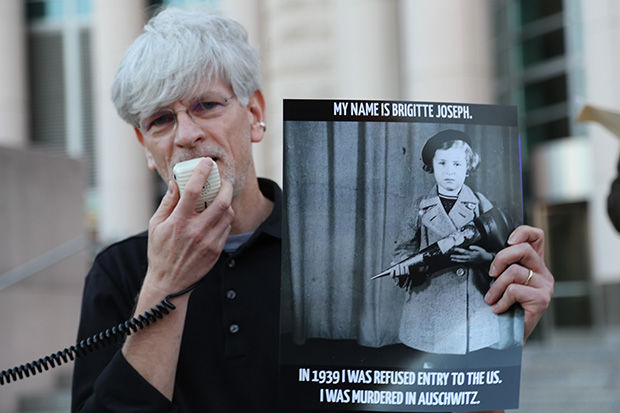Holocaust vigil remembers doomed passengers of the MS St. Louis
Published June 15, 2017
Dozens of people gathered on the steps of the federal courthouse in downtown St. Louis last week to remember Jews who died in the Holocaust after being denied entry to the United States.
“Their lives and their deaths are a constant reminder of the consequences when we turn our backs on refugees fleeing persecution,” said Larry Friedman, a board member of the Jewish Community Relations Council of St. Louis.
The event, held the evening of June 6, marked the 78th anniversary of the end of the voyage of the German ocean liner MS St. Louis, a Havana-bound refugee ship that set off from Hamburg in May 1939. A change in Cuban policy prohibited all but a few of the passengers from disembarking. The rest tried in vain to obtain asylum in the United States or Canada before finally returning to Europe. Of the 937 aboard, 254 eventually perished in the Holocaust.
Last Tuesday’s gathering (June 6) was designed to memorialize those who died as well as advocate for more welcoming policies toward refugees today in the wake of the Syrian civil war and the Trump administration’s executive orders on immigration.
The interfaith gathering was sponsored by groups including the JCRC and the Holocaust Museum and Learning Center. Attendees wore “My people were refugees too” stickers and held placards bearing photos of passengers from the St. Louis who subsequently died. Speakers made brief remarks and read the names of the victims and where their lives had ended.
Rabbi Jim Bennett of Congregation Shaare Emeth took note of the breezy conditions that kept participants from using candles intended for the vigil. He also quoted Emma Lazarus’ poem from the foot of the Statue of Liberty, which promises to “lift my lamp” to the masses.
“Even though we can’t keep the flames lit here today in the wind, perhaps, by our presence and our unity, we can truly rekindle that lamp and remind ourselves over and over that this day today is a commitment to that vision,” Bennett said.
Ghazala Hayat of the Islamic Foundation of Greater St. Louis said the ship’s fate was a reminder of the importance of welcoming immigrants.
“When some are suffering in a faraway land, we should feel their pain and show our compassion, open doors to our land, home and hearts,” she said.
The Rev. Rodrick Burton, a pastor at New Northside Missionary Baptist Church, said he was impressed to see many young people among the vigil’s participants.
“Our consumer culture is one that is constantly focused on the future and the present,” he said. “There is very little regard for remembering and looking backward. If you forget incidents like these, you are doomed to repeat them.”
Vera Emmons, a docent from the Holocaust Museum, told the group that refugee status was a personal issue for her because her grandparents had tried to escape from Germany.
“They worked desperately but unsuccessfully to leave Europe in the years before the killing of Jews began,” she said. “No country would take them in.”
Both died in the Holocaust along with an aunt for whom Emmons was named.
Rabbi Susan Talve of Central Reform Congregation said that her grandparents arrived in America through Ellis Island in the early 20th-century but that their attempts to get other relatives out of occupied Europe failed. They died in concentration camps.
“They, too, were in a boat that had been turned away because the quotas had been filled,” Talve said.
Giovanni Madriz of the Office of Hispanic Ministries at the Archdiocese of St. Louis read his entries from the passenger list in Spanish.
“May we all have always humble hearts, always willing to work toward a better future, keeping in mind the painful lessons from the past,” he said.
Stan Shanker, a JCRC volunteer and a recipient this year of a Jewish Light Unsung Hero award, told attendees why he participated in the vigil.
“It is because I believe,” he said. “I believe that by remembering our past. I believe by remembering the story of the St. Louis. I believe by reciting the names of the victims of this ill-fated voyage. I believe we can learn from our past to help mold our future.”
Steven Engelhardt, communications director for U.S. Rep. William Lacy Clay, a Democrat from St. Louis, said the story of the St. Louis was a failure of courage.
“If we take anything from this tragedy, it is to remember our ability to reach out and summon our national courage not to build walls but to build bridges, not to close doors but to open them to everyone who is oppressed and seeking safety,” Engelhardt said.
Maharat Rori Picker Neiss, executive director of the JCRC, said the ship’s story remains an important one and paraphrased a poem that says each person dies twice.
“The first time is when their body gives out,” she said. “The second time is the last time that their name is said. Coming here tonight and reciting these names means that the story of these individuals lives on. We will not forget what happened to them.”














